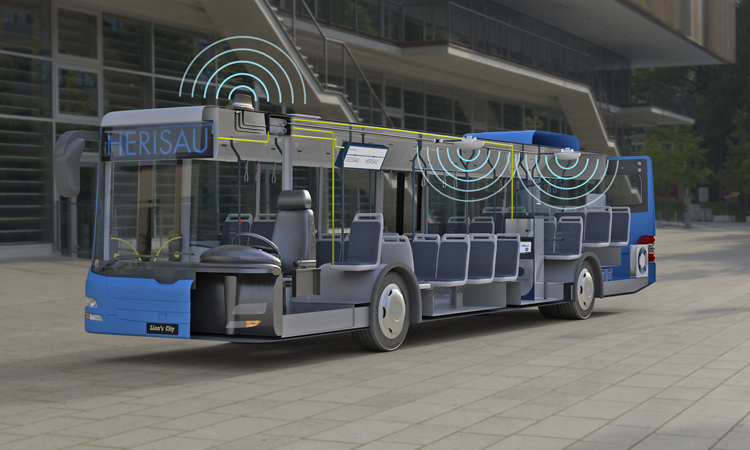Wireless technology on buses: the evolution of the passenger experience
- Like
- Digg
- Del
- Tumblr
- VKontakte
- Buffer
- Love This
- Odnoklassniki
- Meneame
- Blogger
- Amazon
- Yahoo Mail
- Gmail
- AOL
- Newsvine
- HackerNews
- Evernote
- MySpace
- Mail.ru
- Viadeo
- Line
- Comments
- Yummly
- SMS
- Viber
- Telegram
- Subscribe
- Skype
- Facebook Messenger
- Kakao
- LiveJournal
- Yammer
- Edgar
- Fintel
- Mix
- Instapaper
- Copy Link
Posted: 21 October 2016 | Bernd Heidtmann - HUBER+SUHNER | No comments yet
Bus travel is evolving. Gone are the days when passengers waited patiently for their bus to arrive, relying on printed timetables at bus stops – these days we have mobile apps for that. Given this evolution, once on-board, a bus without Wi-Fi is starting to look a little passé. We are also beginning to see more and more travellers opting to leave their car at home over the coming years, as governments continue to invest in infrastructure, coverage and technology. Bernd Heidtmann, Product Manager Antennas at HUBER+SUHNER, discusses the latest technology for buses and how bus operators can get tomorrow’s technology today.


Alongside the encouragement by the authorities to leave our vehicles at home, people are becoming more environmentally conscious, monitoring their carbon footprint and the toll their lifestyle takes on the planet. It is therefore important that public transport operators not only adapt to the change in passenger volume, but understand the ever-evolving needs of the modern commuter.
For these reasons there has been a significant technological awakening that has overhauled the experience on-board all forms of public transport – but, in particular, buses – offering services which are more in-keeping with today’s standards.
Commuter connectivity
‘Passenger experience’ is a term that has been banded around by operators for years, but it has never been more important than it is today. The media often speaks of faster trains, bigger buses and more reasonable travel prices; however, while all of these are admittedly important, passengers are more excited by the in-transit benefits they receive.
Until recently, offering a plug socket to charge electrical devices for free has been the pinnacle of public transport luxury. Now, however, providing consistent, genuinely usable Wi-Fi for passengers is the ongoing battle for operators, in order to enhance their customers’ enjoyment and overall experience of the journey, and the demand is most certainly there.
With office hours being a thing of the past, employees are expected to be contactable and connected at all times. The discerning commuter, therefore, must have fast, reliable access to their emails. Arriving at the office to be greeted by 30 emails that could have been answered on your commute is a frustrating prospect, particularly for the increasing number of professionals who consider their journey time a valuable portion of their working day.
Technology = Security
Of course, technology on-board buses has a variety of applications that become increasingly important as passenger levels rise, and safety is a key concern for all bus operators. A 2007 survey in Malmo1, Sweden found that 38% of the passengers using its municipal bus services had experienced ‘frightening or disturbing situations’ when travelling. After the installation of CCTV on 170 buses across the city, 60% said that they felt safer when using the buses and 17% stated that they were actually choosing to travel by bus more often as a result.
While CCTV is now commonplace across many fleets, the technology is continually improving, with better picture quality and the ability to react quicker to nearly-live feeds significantly improving the safety on-board vehicles.
The LA Metro demonstrates this progression. In 2015 it took the idea of CCTV one step further by introducing security cameras that could transmit images live to the smartphones of law enforcement officials. When compared to similar sized cities across the US, this development has contributed to the Metro being the safest in the country.
We will definitely begin to see other cities adopting this security system in the future, converting all CCTV systems on public transport to smart wireless systems.
Updating wireless systems on-board
Upgrading infrastructure and technology can seem like a hassle, but these changes are proven to make a difference, not only by enhancing the travelling experience, but also by changing peoples’ opinions of public transport and furthering the push by governments and authorities to increase passenger numbers.
The good news for operators is that there are systems available that can be retrofitted to existing vehicles, providing benefits such as CCTV, passenger WLAN and passenger counting systems. This means that many bus operators have the potential to bring their fleet up to date, even if they don’t realise it.
All of these systems work using wireless connectivity. Beside the numerous radio units in use, antennas on the vehicle are very important as they are a crucial component to receive all these signals. If the antenna doesn’t work properly, the performance of the whole system is limited (for example, the achieved data rate for a Wi-Fi on-board system or CCTV). The performance depends not only on the values on the datasheet, but also on the position of the antenna and where it is mounted. Obstacles like A/C units will influence the performance, as well as the metal ground plane the antenna has. However, sometimes the best mounting place can’t be shared between several single element antennas due to the large amount of different antennas. The length of RF cabling can also pose an issue, as long cabling creates signal loss, which, again, is bad for the performance of the system.
If upgraded systems are to be fitted to buses retrospectively, easy mounting is key, with single hole mounts being preferable. This can be accomplished by selecting a solution that combines several radiating elements for different communication standards (cellular, WLAN, GNSS, TETRA, FM radio) for buses within a single product in the best mounting position.
Moving forward
How do we get to the point where we have successfully encouraged more and more people to use buses through enhancing the passenger experience? How far away are we from meeting our goals?
In order to accommodate growing technical requirements, developing smaller and more compact equipment that can be used for multiple purposes is very important. With the creation of MIMO systems and antennas that can easily be retrofitted to buses and replace old antennas with minimal effort, we are definitely on the right path.
The truth is that the end-goal is constantly moving and, as such, the bus industry has to work both proactively and reactively to predict consumer trends and adapt to the unexpected. We have recently seen, for example, the previously ‘science fiction only’ notion of autonomous buses become a very real possibility with the introduction of the Mercedes Future Bus concept.
Couple this with the fact that connectivity systems are already allowing us to plan routes more effectively and pay instantly, and it is looking increasingly likely that we will be able to have a bus experience that involves zero contact with a driver.
Reference
Biography


Related topics
Fleet Management & Maintenance, Security & Crime
Issue
Issue 5 2016
Related modes
Bus & Coach
Related organisations
Huber+Suhner
Related people
Bernd Heidtmann








